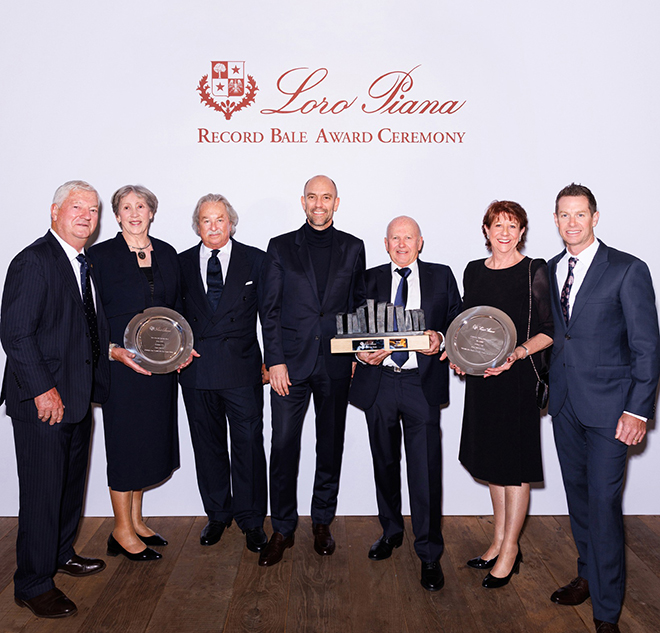Mixed performances in the luxury sector

AWI Global Strategic Advisor Peter Ackroyd reports on mixed performances at the luxury end of the market. Mr Ackroyd is a former President of the International Wool Textile Organisation and is Chief Operating Officer of the Campaign for Wool.
The Loro Piana Record Bale Award has once again been presented to Rob, Pamela and Bradley Sandlant from ‘Pyrenees Park’ in Victoria, this year for a record-breaking 10.2 micron bale. The Award was presented in early February at a ceremony in London that attracted a glamorous crowd from film and theatre (Claire Foy, Richard E Grant, Andrew Garfield and more) together with a coterie of fashion editors and influencers, not seen together in London since pre-Covid days. The New Zealand award went to Barrie and Yvonne Payne of Visuela Farm.
Loro Piana is the sole primary processor in the LVMH luxury goods group that boasts such prestigious headline fashion brands as Christian Dior, Céline, Givenchy, Fendi, Marc Jacobs, Stella McCartney, Kenzo and several more. LVMH is of course market leader in the heady world of expensive watches, fine wine, fancy champagnes and posh perfumery.
“This wool is not just a gift of nature, it is the result of the hard work of exceptional people combined with their passion and true belief in innovation, in the power to change things and improve them day after day. This enables us to create unique masterpieces for the most discerning connoisseurs,” said CEO of Loro Piana, Damien Bertrand, on presenting the awards alongside Vice Chairman of the eponymous company Pier Luigi Loro Piana.

Rob, Pamela and Bradley Sandlant from ‘Pyrenees Park’ in Victoria (right), with Vice Chairman of Loro Piana Pier Luigi Loro Piana and CEO Damien Bertrand (centre), alongside Barrie and Yvonne Payne of Visuela Farm (left) at the presentation of the Loro Piana Record Bale Award.
It perhaps required an event as prestigious as the Loro Piana Record Bale Award to prompt a fresh look at the state of the luxury goods sector, a sector to which the fortunes of several premium quality spinners and weavers in UK and Italy, in particular, are intimately linked.
Whilst perhaps giving the impression of sailing serenely through the troubled waters of the fashion world during the pandemic, the luxury goods sector has recently seen some troubling trends emerge in the once unassailable luxury online marketplace that some, quite erroneously it now transpires, saw as a permanent replacement for boutiques on London’s Bond Street and Melbourne’s Collins Street.
Disquiet at the top end of the trade about the future of an online business model that includes MyTheresa, Net-a-Porter, Flannels and Farfetch, recently prompted a series of doom laden headlines in both the fashion and economic press.
“Can these companies survive the year?” intoned a reporter for the London-based trade journal Drapers.
Luxury online retail platforms Farfetch and MyTheresa have lost 90% of their market value since initial public offerings in 2018 and 2021, reported the Wall Street Journal, that led with a review of the trade under the headline ‘Shopping for luxury online has fallen out of fashion’. It is not only the online retailer that is suffering; luxury brands’ own websites have seen a significant decline in sales since customers started to return to in store sales. Kering recently reported online sales for their leading brand Gucci had fallen by around 30% in the third quarter of 2023.
The news of the death of brick and mortar, maliciously put about by some in the industry during the pandemic, turned out to be the baseless self-fulfilling prophecies several suspected they were at the time.
Travelling back from Pitti Immagine Uomo’s early January trade show in Florence, Italy, where men’s wear collections for the Northern Hemisphere autumn/winter were showcased, leading UK fashion industry observers blamed the current morose state of trade on the vast amount of stock the online retailers had acquired during the pandemic boom.
The heady world of luxury brands seems neatly divided between the bullish and the sluggish with LVMH clearly in the lead and rival Kering (Gucci, St Laurent, Balenciaga, Bottega Veneta) decidedly in the doldrums.
Confirmation of orders for finer worsted fabrics for next winter, currently filtering through from premium brands, seems to suggest LVMH, Hermès and Richemont are performing significantly better than Kering. Analysts suggest LVMH, with a portfolio of 75 brands, is expected to have grown by 9%, whilst Kering is set to see sales figures fall by 4%, according to a consensus of expert opinion recently reported in the Financial Times in London. British brand Burberry, a flagship company supplied by a number of UK and Italian Woolmark licensees recently issued a profit warning.
“We are going to see the further polarisation of this industry in two ways: first of all with the bigger ones outperforming the smaller ones, and the top end of the pyramid outperforming the more aspirational ones,” said Eduard Aubin, luxury goods analyst at Morgan Stanley.
“The key trend for 2023 and 2024 is that high net worth individuals will be driving growth, rather than middle income consumers,” added a senior analyst speaking recently at the Première Vision trade show in Paris.
“Perhaps a rearrangement of the luxury brand market could be to the advantage of Merino spinners and weavers as consumers shy away from bling and seek more personalised luxury where the product is more important than the label,” noted a UK weaver returning recently from Milano Unica, where leading producers were showing collections for the Northern Hemisphere 2025 spring/summer season.
This article appeared in the March 2024 edition of AWI’s Beyond the Bale magazine. Reproduction of the article is encouraged.













